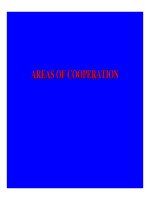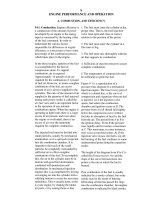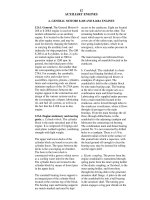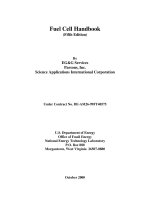Tài liệu Cutting Tools P9 doc
Bạn đang xem bản rút gọn của tài liệu. Xem và tải ngay bản đầy đủ của tài liệu tại đây (884.19 KB, 9 trang )
Cutting
Tool
Applications
Cutting Tool Applications
By George Schneider, Jr. CMfgE
www.toolingandproduction.com
Chapter 9/Tooling & Production
1
9.1 Introduction
One of the most important and essential tools in any metalworking shop is the drilling
machine or drill press. Although the drilling machine is used primarily for drilling holes,
it is often used for reaming, boring, tapping, counterboring, countersinking, and spotfac-
ing.
All drilling machines operate on the same basic principle. The spindle turns the cut-
ting tool, which is advanced either by hand or automatically into a workpiece that is
mounted on the table or held in a drill press vise. Successful operation of any drilling
machine requires a good knowledge of the machine, proper set-up of the work, correct
speed and feed, and proper use of cutting fluids applied to the cutting tool and work.
9.2 Types of Drill Presses
Many types and sizes of drilling machines are used in manufacturing. They range in size
from a simple bench mounted sensitive drill press to the large multiple-spindle machines
able to drive many drills at the same time.
Figure 9.1 shows a schematic diagram of a standard vertical drill press as well as a
schematic diagram of a turret-drilling machine. Described below are these and other
types of drill presses such as sensitive and radial drills.
Chapter 9
Drilling Methods
& Machines
Upcoming Chapters
Metal Removal
Cutting-Tool Materials
Metal Removal Methods
Machinability of Metals
Single Point Machining
Turning Tools and Operations
Turning Methods and Machines
Grooving and Threading
Shaping and Planing
Hole Making Processes
Drills and Drilling Operations
Drilling Methods and Machines
Boring Operations and Machines
Reaming and Tapping
Multi Point Machining
Milling Cutters and Operations
Milling Methods and Machines
Broaches and Broaching
Saws and Sawing
Abrasive Processes
Grinding Wheels and Operations
Grinding Methods and Machines
Lapping and Honing
George Schneider, Jr. CMfgE
Professor Emeritus
Engineering Technology
Lawrence Technological University
Former Chairman
Detroit Chapter ONE
Society of Manufacturing Engineers
Former President
International Excutive Board
Society of Carbide & Tool Engineers
Lawrence Tech. Univ.:
Prentice Hall:
FIGURE 9.1: Schematic illustration of (a) vertical drill press,
(b) CNC turret drilling machine.
(a)
Fixed head
(power head)
Spindle
Adjustable head
Spindle
Chuck
Table
Base
(b)
Column
Turret
Base
Table
Column
Hand
wheel
Chap. 9: Drilling Methods & Machines
2
Tooling & Production/Chapter 9
www.toolingandproduction.com
9.2.1 Simple Drill Press
A simple drill press (Fig.9.2) may be
floor mounted as shown, or have a
shorter main post and be mounted on a
bench. The motions of this machine are
very simple. The table on a floor model
can be raised or lowered and rotated
around the machine column. The spin-
dle rotates and can be raised and low-
ered, with a stroke of 4 to 8 inches.
Stops can be set to limit and regulate the
depth.
9.2.2 Sensitive Drill Press
The name ‘sensitive’ is used to indicate
that the feed is hand operated and that
the spindle and drilling head are coun-
terbalanced so that the operator can
‘feel’ the pressure needed for efficient
cutting. A table mounted sensitive drill
press is shown in Figure 9.3.
The drill press has the same motions
as the previous one plus a telescoping
screw for raising and lowering the table
and a sliding ‘drill head’. These two
features allow easier handling of parts
of varying heights.
9.2.3 Radial Drill
For handling medium to very large size
castings, weldments, or forgings, radial
drills are ideal. The length of the arm
along which the spindle housing rides
specifies their size. This arm can be
from 3 to 12 feet long. The column that
holds the arm may be from 10 to 30
inches in diameter. A radial drill is
shown in Figure 9.4.
For very large work, the arm may be
rotated 180 degrees and work placed on
the shop floor. Speeds and feeds are
dialed in by the machine operator and
are the same as for other drill presses.
Drilling is either hand or power feed.
9.3 Drilling Machine Components
Rigid and accurate construction of
drilling machines is important to obtain
proper results with the various cutting
tools used. The sensitive drilling
machine construction features are dis-
cussed in this section because its fea-
tures are common to most other drilling
machines.
Base: The base is the main support-
ing member of the machine. It is heavy
gray iron or ductile iron casting with
slots to support and hold work that is
too large for the table
Column: The round column may be
made of gray cast iron or ductile iron for
larger machines, or steel tubing for
smaller bench drill presses. It supports
the table and the head of the drilling
machine. The outer surface is machined
to function as a precision way of align-
ing the spindle with the table.
Table: The table can be adjusted up
or down the column to the proper
height. It can also be swiveled around
the column to the desired working posi-
tion. Most worktables have slots and
holes for mounting vises and other
work-holding accessories. Some tables
are semi universal, meaning that they
can be swiveled about the horizontal
axis.
Head: The head houses the spindle,
quill, pulleys, motor, and feed mecha-
nism. The V-belt from the motor drives
a pulley in the front part of the head,
which in turn drives the spindle. The
spindle turns the drill. Two head assem-
blies are shown in Figure 9.2 b and c.
Speeds on a stepped V pulley drive are
changed by changing the position of the
V-belt (Fig. 9.2b) Speeds on a variable-
speed drive mechanism are changed by
a hand wheel on the head. (Fig. 9.2c)
The spindle must be revolving when
this is done.
Quill assembly: The spindle rotates
within the Quill (Fig. 9.5) on bearings.
FIGURE 9.2: a) a sensitive drill press is used for drilling holes; b) speeds on a stepped V
pulley drive are changed by hanging the position of the V belt; c) speeds on a variable-
speed drive mechanism are changed by the handwheel on the head. (Courtesy Clausing
Industries, Inc.)
FIGURE 9.3: A table mounted sensitive
drill used for drilling small holes.
(Courtesy Clausing Industries, Inc.)
Chap. 9: Drilling Methods & Machines
www.toolingandproduction.com
Chapter 9/Tooling & Production
3
The quill moves vertically by means of
a rack and pinion. The quill assembly
makes it possible to feed or withdraw
the cutting tool from the work. Located
on the lower end of the spindle is either
a Morse tapered hole or a threaded stub
where the drill chuck is mounted. For
drilling larger holes, the drill chuck is
removed and Morse tapered cutting
tools are mounted.
Size Classification: The size (capac-
ity) of a drilling machine is determined
by all the following features:
• Twice the distance from the center of
the spindle to the inner
face of the column
• The maximum length
of quill travel
• The size of the Morse
taper in the spindle
• The horsepower of the
motor.
9.4 Drilling Systems
Drilling systems are
usually automated and
computer controlled.
Speeds, feeds, and
depth of cut are often
pre-set. Such systems
combine drilling opera-
tions with reaming, tap-
ping, countersinking, etc.
Figure 9.6 shows a 3-axis
CNC drilling machine.
9.4.1 Multi Spindle
Drilling
This type of drilling can be done on drill
presses by using special attachments.
The spindle locations are adjustable,
and the number of spindles may be from
two to eight. Drills, reamers, counter-
sinks, etc., can be used in the spindles.
The RPM and feed rate of all spindles in
one drill head are the same, and the
horsepower needed is the sum of the
power for all cutting tools used. In this
type of machine, a large number of
holes may be drilled at one time.
Several different diameters of drills may
be used at the same time.
9.4.2 Gang Drilling
An economical way to perform several
different operations on one piece is by
gang drilling as shown in Figure 9.7.
This might include drilling two or more
sizes of holes, reaming, tapping, and
countersinking. The work is held in a
vise or special fixture and is easily
moved along the steel table from one
spindle to the next.
The drill presses usually run continu-
ously so the operator merely lowers
each spindle to its preset stop to perform
the required machining operation.
9.4.3 Turret Drill
Turret drills (Fig. 9.1b) with either six
or eight spindles enable the operator to
use a wide variety of cutters and yet
move the workpiece
only a few inches,
according to the hole
spacing. The turret can
be rotated (indexed) in
either direction, and
then lowered, by hand
or automatically, to
make the cut.
Some turret drills
have automatic,
hydraulically con-
trolled spindles.
Speeds, feeds, and
depths of cut can be
preset for fast produc-
tion. Figure 9.1b
shows an automatic
machine. These
machines are also made
with the entire opera-
tion computer con-
trolled, (CNC turret
FIGURE 9.4: Radial drills are used to machine large cast-
ings, weldments or forgings. (Courtesy Summit Machine
Tool Manufacturing Corp.)
FIGURE 9.7: Gang drilling machines permit
economical ways to perform several different
operations. (Courtesy Clausing Industries,
Inc.)
FIGURE 9.6: Shown is a 3-axis CNC drilling
Machine (Courtesy: TechniDrill Systems, Inc.)
FIGURE 9.5: The spindle rotates within the quill.
The quill moves vertically by means of a rack and
pinion. (Courtesy: Clausing Industries, Inc.)
Chap. 9: Drilling Methods & Machines
4
Tooling & Production/Chapter 9
www.toolingandproduction.com
drill), so that the operator merely has to
load and unload the parts. A numerical-
ly controlled turret drill is shown in
Figure 9.8.
9.5 Operation Set-up
In drilling operations the three most com-
mon work holding methods are:
• Vises
• Angle Plate
• Drill Jigs
Vises: Vises are widely used for
holding work of regular size and shape,
such as flat, square, and rectangular
pieces. Parallels are generally used to
support the work and protect the vise
from being drilled. Figure 9.9 shows a
typical vise. Vises should be clamped to
the table of the drill press to prevent
them from spinning during operation.
Angular vises tilt the workpiece and
provide a means of drilling a hole at an
angle without tilting the table. An angu-
lar vise is shown in Figure 9.10.
Angle Plates: An angle plate sup-
ports work on its edge. Angle plates
accurately align
the work perpen-
dicular to the
table surface, and
they generally
have holes and
slots to permit
clamping to the
table and holding
of the workpiece.
Drill Jigs: A
drill jig is a pro-
duction tool used
when a hole, or
several holes,
must be drilled in
a large number of
identical parts.
Figure 9.11 shows
a diagram of a typical drill jig. The drill
jig has several functions. First, it is a
work holding device, clamping the work
firmly. Second, it locates work in the cor-
rect position for drilling. The third func-
tion of the drill jig is to guide the drill
straight into the work. This is accom-
plished by use of drill bushings.
9.5.1 Tool Holding Devices
Some cutting tools used in drilling
can be held directly in the spindle
hole of the machine. Others must
be held with a drill chuck, collet,
sleeve, socket, or one of the many
tool-holding devices shown in
Figure 9.12.
Drill Chucks: Cutting tools with
straight shanks are generally held in
a drill chuck. The most common
drill chuck uses a key to lock the
cutting tool. Drill chucks, both with key
and keyless, are shown in Figures 9.13.
Sleeves: Cutting tools with tapered
shanks are available in many different
sizes. When a cutting tool that has a
smaller taper than the spindle taper
used, a sleeve must be fitted to the
shank of the cutting tool.
Sockets: If the cutting tool has a
tapered shank larger than the spindle
taper, a socket is used to reduce it to the
correct size. Figure 9.14 shows various
size keyless drill chucks with one
straight and two tapered shank mount-
ings.
9.6 Deep-hole Drilling
The term ‘deep holes’ originally
referred to hole depths of over 5 x the
diameter. Today, deep-hole drilling is a
collective name for methods for the
FIGURE 9.9: Vises should be clamped to the
table of drill presses to prevent them from spin-
ning. (Courtesy Kurt Manufacturing Co.)
FIGURE 9.11: Drill jigs locate and clamp workpieces, and guide the
drill through a drill bushing.
FIGURE 9.10: The angle vise tilts the workpiece and pro-
vides a means of drilling a hole at an angle. (Courtesy:
Palmgren Steel Products, Inc.)
FIGURE 9.8: Numerically controlled turret drill automatically
positions the worktable. (Courtesy: Kanematsu USA, Inc.)
Drill bushings
Thumb screw
Locating pins
Bottom View
Workpiece









